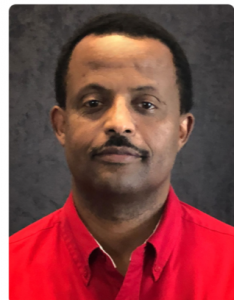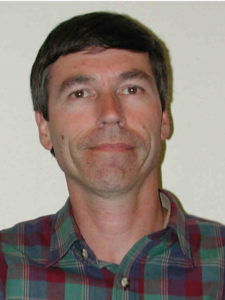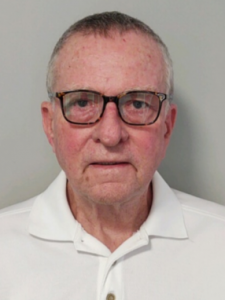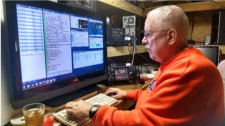 Mehari Tekeste is an associate professor leading a research team on Physical Systems Modeling and Simulation of Agricultural and Off-Road Machinery Systems at the Department of Agricultural and Biosystems Engineering (ABE) at Iowa State University (ISU), Ames, Iowa. Dr. Tekeste teaches an undergraduate course Functional Analysis of Soil, Crop and Machine Systems, and a graduate-level course on Modeling and Simulation of Soil-Crop-Machine Systems. His current research focus includes (1) developing models of particle (soil & crop)-to-machine interactions, and advancing multi-physics virtual engineering analysis for off-road equipment design and machine performance analysis, and (2) advancing soil dynamics research for soil compaction, traction, and tillage precision applications. Dr. Tekeste has also industry experience working in design and performance analysis of various Ground Engaging Tools (GET) (subsoiler, cultivator sweep, loader buckets) for Agriculture and Construction equipment, virtual performance analysis of large tractor tire/track design solutions for predicting traction forces and soil deformation, and modeling crop handling systems of crop harvesting equipment.
Mehari Tekeste is an associate professor leading a research team on Physical Systems Modeling and Simulation of Agricultural and Off-Road Machinery Systems at the Department of Agricultural and Biosystems Engineering (ABE) at Iowa State University (ISU), Ames, Iowa. Dr. Tekeste teaches an undergraduate course Functional Analysis of Soil, Crop and Machine Systems, and a graduate-level course on Modeling and Simulation of Soil-Crop-Machine Systems. His current research focus includes (1) developing models of particle (soil & crop)-to-machine interactions, and advancing multi-physics virtual engineering analysis for off-road equipment design and machine performance analysis, and (2) advancing soil dynamics research for soil compaction, traction, and tillage precision applications. Dr. Tekeste has also industry experience working in design and performance analysis of various Ground Engaging Tools (GET) (subsoiler, cultivator sweep, loader buckets) for Agriculture and Construction equipment, virtual performance analysis of large tractor tire/track design solutions for predicting traction forces and soil deformation, and modeling crop handling systems of crop harvesting equipment.
In his career, Dr. Tekeste published over fifty papers, and supervised many graduate students, postdoctoral associates, and visiting scholars within his research area. He is Editor of the Journal of Terramechanics, and actively involved in standards development and leadership roles related to soil dynamics in the International Society of Terrain-Vehicle Systems (ISTVS), and American Society of Agricultural and Biological Engineering (ASABE) professional societies. Recently he has established a new Soil Machine Dynamics Laboratory at ISU consisting of three soil bin equipment (1) single-tire testing for mobility studies, (2) blade bin for GET design and performance analysis, and (3) a circular soil bin for accelerated wear testing.

Thomas Way is an Agricultural Engineer at the USDA-ARS National Soil Dynamics Laboratory in Auburn, Alabama. He has conducted research determining tractive performance and soil compaction characteristics of agricultural vehicles. His research includes investigating effects of loads and inflation pressures of agricultural drive tires, investigating the lug height of agricultural drive tires, investigating the aspect ratio of agricultural drive tires, and comparing a mechanical front-wheel drive (MFWD) tractor with a rubber track agricultural tractor. His work includes using Stress State Transducers (SSTs) for determining stresses in soil beneath tires and rubber tracks, measuring soil-tire and soil-track interface pressures on the treads of tires and rubber tracks, investigating deflections of tire tread relative to the rim, and research about power hop which is an undesirable hopping of a tractor or other vehicle. His research also includes development of a prototype field implement for shallow subsurface band application of poultry litter, which is a mixture of poultry manure and a bedding material, such as wood shavings. His work includes investigating the performance of closing wheels on row crop planters. He has authored or coauthored over 80 peer-reviewed journal articles and is an inventor on one US patent.
 Paul is a retired Caterpillar engineer. Thirty-six of his thirty-eight-year career was spent with earth mechanics research. Paul worked in product research and development with all earthmoving tools and attachments and mobility, traction, and compaction systems. His work entailed soil and rock earthen materials, as well as landfill waste and asphalt paving materials. He says if it was dirty, hard, smelled and/or was hot, he probably worked with it. Paul worked on many product innovations, including the Caterpillar belt track ag tractor; and intelligent compaction, as two examples. His work was with both similitude (scale model) systems and field testing. He retired as manager of Caterpillar’s earth mechanics lab, where soil bins were the primary research tool, and manager and technical leader for Caterpillar’s earth mechanics technology. Paul began life on a small farm in Nebraska, attending a one-room country school. He graduated in Agricultural Engineering with a master’s degree from the University of Nebraska and began employment at Caterpillar following his college education. He did cooperative research with Iowa State University (ISU) during his work career and continues to be in touch with ISU to provide information from his earth mechanics background.
Paul is a retired Caterpillar engineer. Thirty-six of his thirty-eight-year career was spent with earth mechanics research. Paul worked in product research and development with all earthmoving tools and attachments and mobility, traction, and compaction systems. His work entailed soil and rock earthen materials, as well as landfill waste and asphalt paving materials. He says if it was dirty, hard, smelled and/or was hot, he probably worked with it. Paul worked on many product innovations, including the Caterpillar belt track ag tractor; and intelligent compaction, as two examples. His work was with both similitude (scale model) systems and field testing. He retired as manager of Caterpillar’s earth mechanics lab, where soil bins were the primary research tool, and manager and technical leader for Caterpillar’s earth mechanics technology. Paul began life on a small farm in Nebraska, attending a one-room country school. He graduated in Agricultural Engineering with a master’s degree from the University of Nebraska and began employment at Caterpillar following his college education. He did cooperative research with Iowa State University (ISU) during his work career and continues to be in touch with ISU to provide information from his earth mechanics background.

Dr. Robert L. Schafer earned his BS and MS in Agricultural Engineering, and his PhD in Agricultural Engineering and Engineering Mechanics; minor, Soil Physics at Iowa State University, Ames, Iowa. Dr. Schafer has a research career in Agricultural Engineering for 35 years working 5 years part-time with the USDA-ARS in Ames, Iowa and 30 years at the National Soil Dynamics Laboratory (NSDL) in Auburn, Alabama. His contribution to the body of knowledge in Agricultural Engineering is exemplified by numerous publications in domestic and foreign peer reviewed technical journals, many of which relate to either scale or mathematical modeling of soil-machine systems. He has made numerous technical presentations, both nationally and internationally, before professional technical societies, conferences, workshops, and seminars. Dr. Schafer and an engineering colleagues from Deere and Co. in Moline, IL and the U.S. Army Corps of Engineers in Vicksburg, MS organized a seminar series titled Similitude of Soil-Machine Systems which were held throughout the country. The materials developed in these seminars was compiled into an American Society of Agricultural and Biological Engineers (ASABE) special publication. On an international basis Dr. Schafer was co-organizer and co-host of the First International Conference on Soil Dynamics. His applied research contributions have had a significant impact on the machinery industry, such as helping a company improve the design of an efficient rolling cultivator, and his development of automatic guidance systems for agricultural machinery. Beyond agriculture Dr. Schafer assisted the Bell Laboratories develop an efficient sea plow for burying transatlantic cables on the ocean floor. Dr. Schafer was an Adjunct Professor in the Agricultural Engineering Department at Auburn University, Auburn, Alabama. He was also a member of the Auburn University Graduate Faculty and served as an advisor and as a graduate committee member for graduate students in Agricultural Engineering. At the NSDL his contributions include serving as Research Leader of the Tillage Research Unit and also serving as Laboratory Director. Dr. Schafer’s service to the ASABE included serving on 9 different important national committees, serving as an officer in 7 of these committees. In addition he was elected a Regional Director, a member of the Board of Trustees, and a member of the Board of the ASABE Foundation. He was elected as a Fellow of the ASABE. The ASABE awarded Dr. Schafer the Cyrus Hall McCormick-Jerome Increase Case Gold Medal which honors exceptional and meritorious engineering achievement in agriculture that has resulted in new concepts, products, processes or methods that advanced the development of agriculture.

Dr. Vladimir V. Vantsevich is a professor at the Department of Mechanical Engineering, the University of Alabama at Birmingham. Prof. Vantsevich also serves as Director and PI of the Autonomous Vehicle Mobility Institute Program. Prof. Vantsevich’s research area is mechanical and intelligent mechatronic multi-physics systems, system modeling, design and control. Applications include autonomous and conventional multi-wheel off-road vehicles, vehicle driveline systems and chassis. He developed a new research avenue – inverse ground vehicle dynamics, which is the basis of his optimization of power distribution among the drive wheels and control of vehicle mobility, energy/fuel consumption, traction performance, maneuver and stability of motion. Prof. Vantsevich’s recent research work on autonomous vehicles is on coupled and interactive dynamics of vehicle systems, agile tire dynamics, virtual drivelines for electric and hybrid vehicles, and AI-based morphing of autonomous vehicles.